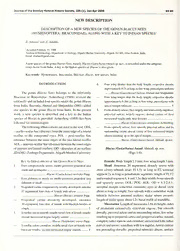
Description of a new Species of the Genus Blacus Nees (Hymenoptera: Braconidae), Along with a Key To Indian Species PDF
Preview Description of a new Species of the Genus Blacus Nees (Hymenoptera: Braconidae), Along with a Key To Indian Species
Journal ofthe Bombay Natural HistorySociety, 105 (1),Jan-Apr2008 84-85 NEW DESCRIPTION DESCRIPTION OFANEW SPECIES OFTHE GENUS BLACUS NEES (HYMENOPTERA: BRACONIDAE), ALONG WITH A KEYTO INDIAN SPECIES1 Z.Ahmad2 andZ.Ahmed 'AcceptedFebruary 13,2008 ^SectionofEntomology, DepartmentofZoology,AligarhMuslimUniversity,Aligarh202002,UttarPradesh,India. Email: [email protected] AnewspeciesofthegenusBlacusNees,namelyBlacus(Ganychorus)hayatisp.nov.,isdescribedunderthesubgenus Ganychorusfrom India. Akey tothe Indian speciesofBlacus is also given. Key words: Hymenoptera. Braconidae, Blacinae, Blacus, new species, India INTRODUCTION 4. Fore wing shorter than the body length; ovipositor sheaths approximately0.2xaslongasforewing;pterostigmauniform The genus Blacus Nees belongs to the subfamily — Blacus(Ganychorus) indicus Ahmad and Shujauddin Blacinae of Braconidae. Aehterberg (1988) revised the Fore wing longer than the body length; ovipositor sheaths subfamily and included fourspecies underthe genus Blacus approximately0.16xaslongasforewing; pterostigmawith from India. Recently, Ahmad and Shujauddin (2001) added apical margin infuscate 5 one species to the genus Blacus from India. In the present 5. Fronsdenselysetose;facelargelyandtransverselyrugulose; work, a new species is described and a key to the Indian precoxal sulcus widely rugose; dorsal carina of first species of Blacus is provided. Aehterberg (1988) has been metasomal tergite only neardorsope followedforterminologies. — Blacus(Ganychorus) setosifrons Aehterberg The followingabbreviations areused in thetext: OOL Frons sparsely setose; face smooth; precoxal sulcus and its —ocello-ocularline (distancefromtheouteredgeofalateral surrounding striate; dorsal carina offirst metasomal tergite ocellus to the compound eye); POL - post-ocellar line almostreaching up tothe apical margin (distance between the inneredges ofthe two lateral ocelli); Blacus(Ganychorus) hayatiAhmad, sp.nov. AOL-anterior-ocellarline(distancebetweentheinneredges ofanteriorandlateral ocellus), OD-diameterofanocellus; Blacus (Ganychorus)hayatiAhmad, sp. nov. ZDAMU-Zoology Department,AligarhMuslim University. (Figs 1-4) Keyto Indian speciesoftheGenus Blacus Nees Female: Bodylength2.5 mm; forewinglength3 mm. 1. Eyes conspicuously setose; medio-posteriorpropodeal area Head: Antennae 20 segmented, densely setose with small and rectangular short silvery-whitish setae; FI 1.5x as long as F2, terminal — Blacus (Contochorus) turbidus Papp. segment2xaslongaspenultimatesegments;lengthofFI,F2 Eyes glabrous ornearly so; medio-posteriorpropodeal area andterminal segment6,4and3.5xtheirwidth;fronssmooth differentorsmall 2 and sparsely setose; OOL: POL: AOL: OD = 4:3:2.5:1; 2. Propodealcarinacomparativelyweakly developed; antenna occipital margin somewhat crenulate; eyes in dorsal view 17 segmented; fore claw offemale only setose aboutas longas temple; facesmooth withasomewhatweak Blacus Blacus imitatorPapp. tubercle between antennal sockets; malar suture present; — ( ) Propodeal carina distinctly developed; antennae length ofmalarspace about 1.2x basal width ofmandible. 20 segmented; fore claw offemale with blackish bristles or Mesosoma: Lengthofmesosoma 1.6xitsheight;sides simple 3 of pronotum extensively reticulate rugose, but smooth 3. Scutellarsulcussmooth;middletarsalclawoffemalesimple; dorsally;precoxalsulcusanditssurroundingstriate,fewstriae second metasomal tergite largely costate reachinguptoprepectalcarinaandpostpectalcarina;notauli Blacus (Tarpheion) votrus Papp. completerathernarrowandcrenulate;mesoscutalloberather Scutellarsulcuscrenulate;middletarsalclawoffemalewith convexandsetose;scutellumwithfewrugulae,lateralcarinae blackish bristles; second metasomal tergite smooth 4 not protruding dorsally; propodeal tubercles absent, surface NEW DESCRIPTION clypeus, tegulae, pterostigma (except infuscated margin of apical half), fore leg, mid leg, hind leg (except telotarsus), second and third tergite largely pale yellowish; face, vertex behindeyes,mesoscutumandapexofhypopygiumyellowish brown; wings hyaline membrane, veins largelydarkbrown. Male: Unknown mm 1.0 Holotype: ?, India: Uttar Pradesh, Rampur; 13.iii.2003, Coll. Z. Ahmed (ZDAMU). Paratypes: 1 9, same as holotype (ZDAMU) Host: Unknown. Distribution: India: UttarPradesh. Etymology: The species has been named inhonourof Dr. Mohammed Hayat for his contribution towards the knowledge ofparasitic Hymenoptera. Remarks: Blacus(Ganychorus)hayatiAhmadsp.nov. closely resembles Blacus Gancychorus setosifrons ( ) Achterberg,butdiffersinhavingfronssparselysetose(frons densely setose in setosifrons); face smooth (face largely 1. FoFirges:wi1n-g4;: 2B4..laHPceruaosdp,(oGdfareonunymtca,lhoTvri1oeuaw;sn)d3.hTyM2aitditsapr.sanlovc.law; tsrualncsuvserasnedlyitosrsoubrlrioquunedliynrgugsturlioastee (inprseectooxsailfrsounslc);usprweicdoexlayl rugose in setosifrons); dorsal carinae of first metasomal of propodeum largely smooth, its median area absent; fore tergitealmostreachinguptotheapicalmargin(dorsalcarinae wing with first discal cell truncate anteriorly; 2-CU1 about offirst metasomal tergite only neardorsope insetosifrons). 2.Ox as long as 1-CU1; parastigma rather large; length of Thetype materialisdepositedinZoological Museum, hind femur, tibia and basitarsus 6x, 9x and 8x their width DepartmentofZoology,Aligarh MuslimUniversity,Aligarh. respectively;foreandmiddleclawwithblackishbristlesand ACKNOWLEDGEMENTS teeth; hind claw simple, only whitish (bristly) setose. Metasoma:Lengthoffirsttergite 1,65xitsapicalwidth, longitudinally rugose, dorsal carinae almost reaching up to We thank Dr. M. Hayat and Dr. Shujauddin for theapicalmargin;secondtergitesmooth;lengthofovipositor reviewing the manuscript and offering useful suggestions. sheaths approximately 0.16x offore wing. We are also thankful to Chairman, Department of Zoology Colour: Darkreddishbrown;palpi, mandible,ventral forlaboratory facilities. REFERENCES Achterberg,C. Van(1988): Revisionofsubfamily BlacinaeFoerster Ahmad, Z. & Shujauddin (2001): A new species ofthe genus Blacus (Hymenoptera, Braconidae). Zool.Verh-hand. Leiden. 249: Nees(Blacinae:Braconidae:Hymenoptera)fromIndia.Shashpa 1-324. 8(1): 15-18. J. Bombay Nat. Hist. Soc., 105 (1), Jan-Apr 2008 85
